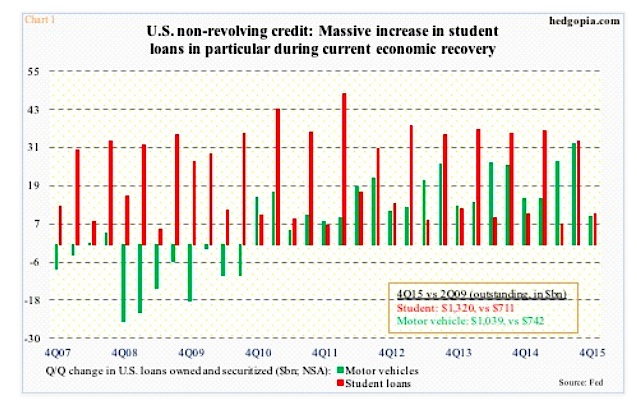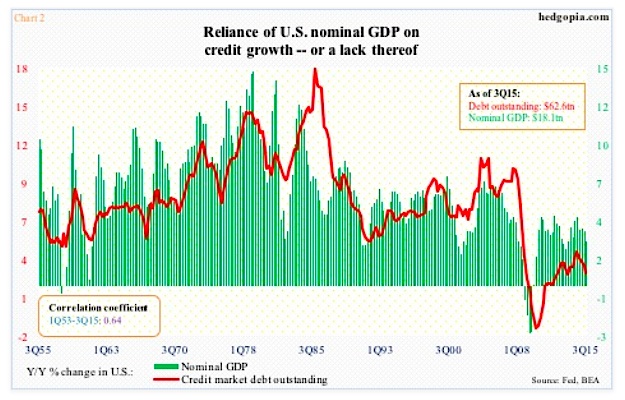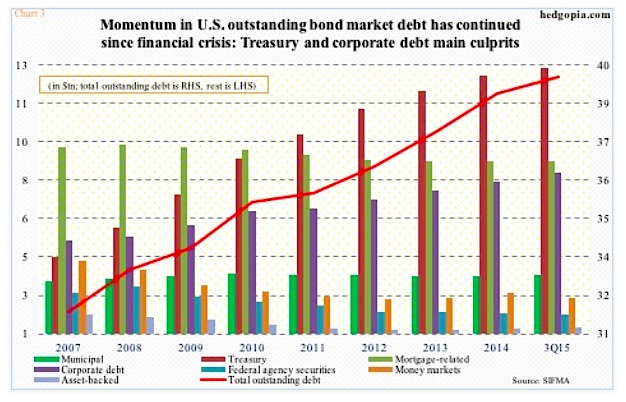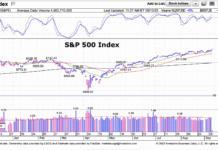Both student loans and automobile loans made a fresh new high in 4Q15. That shouldn’t be viewed as “new” news. Both these loans have been trending higher in the current cycle. When Great Recession ended, student loans were $710.9 billion. At the end of the fourth quarter last year, they stood at $1.32 trillion. Motor-vehicle loans were $742 billion and $1.04 trillion, respectively.
Here is another way to look at this.
As a share of nominal GDP, auto loans were 5.2 percent in 2Q09, rising to 5.7 percent by 4Q15. Student loans were five percent then and 7.3 percent now. That is the news. The sheer size of it – particularly student loans.
Time will tell how this is all going to shake out. For now, both these loans have already gotten so big that it is not healthy that they continue to grow; particularly student loans due to a still imperfect job market.
In 4Q15, growth did indeed slow, with motor vehicles rising $9 billion quarter-over-quarter and student $9.6 billion. Versus past quarters, the bars on the right side of Chart 1 look so tiny.
From the perspective of getting the overall size of these loans under control, this is good. But not so from the perspective of contribution to economic growth.
Real GDP grew a mere 0.7 percent in 4Q15. The rather sluggish growth in both motor-vehicle and student loans probably played a part.
The U.S. economy’s over-reliance on debt is best seen in Chart 2. Between 1Q53 and 3Q15, the correlation coefficient between nominal GDP ($18.1 trillion in 3Q15) and debt outstanding ($62.6 trillion in 3Q15) was 0.64 – decent. The red line and green bars follow each other closely. As goes debt creation, so goes GDP.
In this regard, one constant meme we hear is how post-Great Recession the economy has deleveraged. No such thing. Nothing could be further from the truth.
If deleveraging was taking place in earnest, the economy would be growing even weaker. Post-Great Recession, growth in real GDP averaged a mere 2.1 percent, versus 3.2 percent going all the way back to 2Q47.
This, despite the surge in debt – total debt outstanding went from $54.6 trillion in 2Q09 to $62.6 trillion in 3Q15. Federal debt grew from $11.5 trillion in 2Q09 to $19 trillion now.
Chart 3 breaks down the outstanding U.S. bond market debt into several buckets, and the red line, representing the total amount, continues to rise from lower left to upper right – $33.9 trillion in 2009, rising to $39.6 trillion in 3Q15.
Most notable is corporate debt, which rose from $5.9 trillion in 2009 to $8.2 trillion in 3Q15. And yes, we do hear talk of ongoing deleveraging in the corporate world. No such thing.
Thanks for reading!
Twitter: @hedgopia
Read more from Paban on his blog.
Any opinions expressed herein are solely those of the author, and do not in any way represent the views or opinions of any other person or entity.











